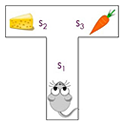The Successor Representation: Its Computational Logic and Neural Substrates. J Neurosci.
In this paper, Gershman presents and builds upon a reinforcement learning algorithm first proposed by Peter Dayan in 1993, called the successor representation, which solves some important problems that previous classes of reinforcement learning algorithms have had. Recent research has supported the idea that humans and other animals use successor representations for learning and decision making under some conditions and has proposed that dopaminergic mechanisms could build successor representations in the brain. [Read More]










